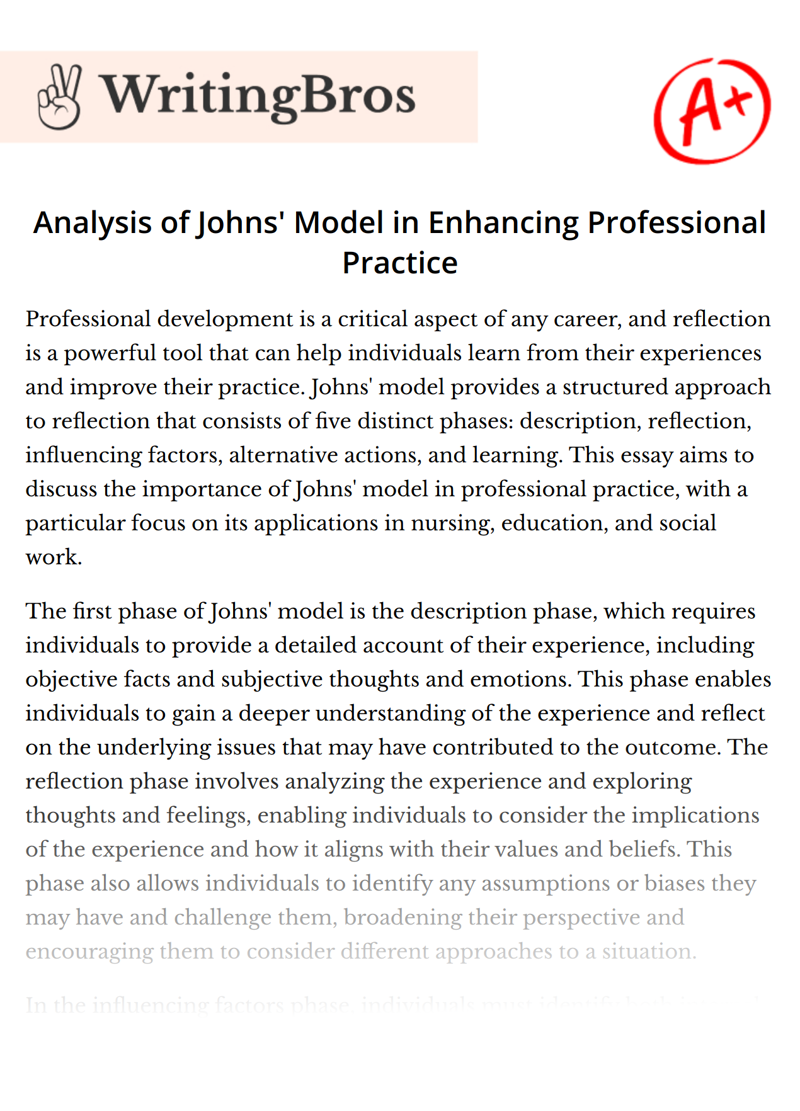Analysis of Johns' Model in Enhancing Professional Practice

Professional development is a critical aspect of any career, and reflection is a powerful tool that can help individuals learn from their experiences and improve their practice. Johns' model provides a structured approach to reflection that consists of five distinct phases: description, reflection, influencing factors, alternative actions, and learning. This essay aims to discuss the importance of Johns' model in professional practice, with a particular focus on its applications in nursing, education, and social work.
The first phase of Johns' model is the description phase, which requires individuals to provide a detailed account of their experience, including objective facts and subjective thoughts and emotions. This phase enables individuals to gain a deeper understanding of the experience and reflect on the underlying issues that may have contributed to the outcome. The reflection phase involves analyzing the experience and exploring thoughts and feelings, enabling individuals to consider the implications of the experience and how it aligns with their values and beliefs. This phase also allows individuals to identify any assumptions or biases they may have and challenge them, broadening their perspective and encouraging them to consider different approaches to a situation.
In the influencing factors phase, individuals must identify both internal and external factors that influenced the experience. By examining these factors, individuals can identify patterns and make changes that can lead to improved outcomes in the future. The alternative actions phase encourages individuals to consider different options for handling similar situations in the future, expanding their repertoire of responses and helping them to develop new skills. Finally, in the learning phase, individuals synthesize the insights gained from reflection and apply them to their future practice, developing an action plan that includes specific goals, objectives, and a timeline for achieving them.
Johns' model can be applied across various professional contexts, including nursing, education, and social work. In nursing, reflection is essential in improving communication skills with patients. Nurses can reflect on challenging patient interactions to identify ways to be more empathetic, establish better rapport, and manage their emotions effectively. Additionally, nurses may reflect on clinical practices and identify areas where they can improve the quality of care they provide.
In education, Johns' model can be used to reflect on a difficult lesson and identify ways to engage students more effectively. By reflecting on student feedback, educators can adjust their teaching approach to cater to diverse learning styles and improve their teaching practice, creating a more inclusive learning environment. Moreover, educators can reflect on their interactions with colleagues and identify ways to enhance teamwork and collaboration.
Social workers can use Johns' model to reflect on a case and identify ways to improve advocacy for clients. By reflecting on their interactions with clients, social workers can identify gaps in their knowledge and skills and develop strategies to address them. They can also consider the broader societal and institutional factors that may be affecting their clients and work towards systemic change. In addition, social workers can reflect on their own biases and prejudices and develop strategies to address them.
In conclusion, Johns' model for structured reflection is a valuable tool for enhancing professional development and practice. By applying the five phases of Johns' model, individuals can analyze experiences, identify areas for improvement, and develop an action plan to achieve their goals. Reflection is a continuous process, and it is essential to integrate it into daily practice to ensure ongoing development and improvement. The applications of Johns' model are broad and varied, making it a valuable resource for professionals looking to enhance their practice.
Cite this Essay
To export a reference to this article please select a referencing style below

